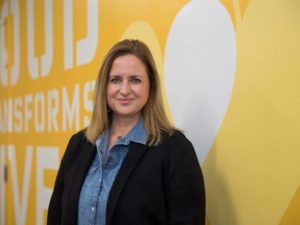100 days into her tenure at the Food Bank, Executive Director Tanis Crosby reflects on her experience, her gratitude, and on the enormity of the imperative work ahead.
 What’s your overall pulse, 100 days in?
What’s your overall pulse, 100 days in?
I feel incredibly grateful and humbled and… at home.
What’s one memory from your first 100 days that will stick with you?
One Wednesday evening, I volunteered packing boxes of food for seniors. Music was playing through the speakers—whoever curates our playlists is just magical—and next to me was this lovely man named John, who had been volunteering with us on Wednesdays for 21 years, wearing his food bank sweatshirt as a badge of pride. Next to John were a couple of women who were having a blast working together, just completely welcoming, and some families who came to volunteer as a unit. It was this beautiful community within a community that had sprung up.
At the end of the shift, the Food Bank project leader Robert announced how many pounds we had collectively packaged, and I looked around and felt such pride and celebration of taking action to fight hunger together. It was such a clear image of our vital service and the wholly unique way in which we bring the community together for a great cause. It was a moment.
Your second 100 days may look very different from your first as vaccines roll out. How is that changing the way you think about our priorities?
The pandemic is revealing that which we already knew to be true: Poverty and racism are inextricably linked to food insecurity. That is not going to go away when the masks go away. We’re going to focus on advancing our mission with the analysis and the framework that this team’s wisdom created, which is understanding that we are addressing not only the consequences of hunger, but also the causes. We will work on upstream and lasting solutions and are steadfast in our commitment to ensure we are making meals possible for our neighbors right now.
As we look forward, we also need to determine what it means to sustainably serve all of those who need us – those we are currently reaching and those we hope to reach. After more than a year spent responding to this crisis, how do we return to solutions we know work, but weren’t possible during the pandemic – like a farmer’s market style distribution to enable choice – and what innovations from our crisis response do we maintain – like the grocery delivery. This will be hard work, but it is essential work. The Food Bank is part of a critical safety net that is made up of grassroots, well-established, and new community-led organizations as well as government programs. Together we will find the solutions. Because we are all working collectively to fulfill our purpose of ending hunger.
This isn’t just a vision, it will be a future, with partners, donors and volunteers making it real.
Do you think there are ways in which the pandemic has changed our community for the better?
The pandemic was a stark reminder that you can work hard, get a job, and still find yourself at risk of homelessness or relying on the Food Bank to make sure that you’re not choosing between your PG&E bill and feeding your family. You can have good job and not be able to make ends meet in San Francisco or Marin.
That’s not going to go away anytime soon. And what it has created is empathy and a deep-seated understanding that food is a human right. The community wants to be part of taking care of each other. Whether they are a 10 year-old donating their small proceeds from a lemonade stand, or a Foundation giving millions, donors of all ages, of all means are recognizing that we’ve got to take care of each other. And that has been completely inspiring.
The Food Bank just announced its Capital Campaign to expand warehouse facilities. How do you envision that helping to chart our way forward?
In this coming year, we have a tall order. Delivering on these expansion plans is really about delivering on current community need; we started this project 5 years ago with the goal of building for the future, but it turns out we are building for right now.
We are renovating not to expand, but to sustain. Because it’s not about a building and it’s not about the number of pounds of food, it’s about having the space to feed our neighbors who are making real and practical choices every day about where they’re spending scarce dollars. Our community is hurting. People are making choices–choices that weigh on families, choices that are hard and hurt.
Our job is to relieve that hurt, to make it less stressful and more hopeful. It is not about a building. It’s about what happens as a result of having that capacity to deliver on this critical need, person, by person, by person, in all of the neighborhoods in which we serve.
What has surprised you most during your first 100 days?
What surprised me was what it means to see that sheer scope upfront, to see it come alive in the field. What surprised me was how excited I would feel to see the orders being built, knowing that they would be landing in a neighborhood pantry, a pop-up or a drive-thru and put into the hands of people in our community, our neighbors. Just the magnitude of what this scale feels like, to see it and to know what it means, not just hear about it or read about it, but to see it. And just the enormous sense of… I can’t think of another word other than pride. I feel so proud to be part of this team – staff, donors, and volunteers – that is delivering food and hope to every corner of our community.


Share